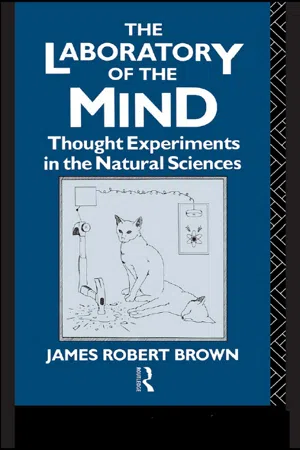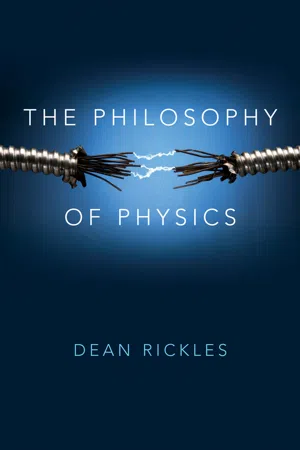Physics
Eigenstate
An eigenstate in physics refers to a state of a physical system that remains unchanged when a specific operator is applied to it. In quantum mechanics, eigenstates are associated with measurable properties of a system, such as energy or momentum. They play a crucial role in understanding the behavior and properties of quantum systems.
Written by Perlego with AI-assistance
5 Key excerpts on "Eigenstate"
Learn about this page
Index pages curate the most relevant extracts from our library of academic textbooks. They’ve been created using an in-house natural language model (NLM), each adding context and meaning to key research topics.
- eBook - ePub
The Laboratory of the Mind
Thought Experiments in the Natural Sciences
- James Robert Brown(Author)
- 2011(Publication Date)
- Routledge(Publisher)
The properties that the system can have, e.g., position, momentum, angular momentum, energy, spin, etc. are called observables (though often there is nothing observable about them) and are associated with operators. Examples in one dimension are: the position operator: X = x, and the momentum operator: P = – iħd / dx. Operators are functions defined on the Hilbert space. For example, if |ψ〉 = e ipx/ħ then we have P |ψ〉 = iħd (e ipx/ħ)/ dx = (– iħ) (ip / ħ) e ipx/ħ = pe ipx/ħ. Whenever an operator, O, has the effect of just multiplying a vector by a real number r, the vector is called an eigenvector of that operator. That is, if O |ψ〉 = r|ψ〉 then |ψ〉 is an eigenvector and r is called an eigenvalue. According to the third principle, only eigenvalues can be the results of any measurement. In the simple example just given, p is an eigenvalue and will be the magnitude revealed on measurement. (At least in the ideal case—it is acknowledged by all that real life is messy.) Figure 26 The state of the system might correspond to one of the eigenvalues, but it need not in general; often it will be in a state of superposition, a linear combination of two or more eigenvectors (which are the basis vectors of the space). The extent to which |ψ〉 overlaps some eigenvector gives the probability amplitude of getting the corresponding eigenvalue as a result of measurement. Generally, the state of the system will change as time passes. This is represented by having |ψ〉 move around in the Hilbert space in a manner governed by the Schrödinger equation. This change of state is smooth and deterministic. When two quantum systems interact they remain ‘entangled’ in some sense, even when far removed from one another. The tensor product of two such states is not a simple product of these two states considered separately. The combined state has some remarkable properties of its own - eBook - ePub
The Laboratory of the Mind
Thought Experiments in the Natural Sciences
- James Robert Brown(Author)
- 2005(Publication Date)
- Routledge(Publisher)
The properties that the system can have, e.g., position, momentum, angular momentum, energy, spin, etc. are called observables (though often there is nothing observable about them) and are associated with operators. Examples in one dimension are: the position operator: X = x, and the momentum operator: P =- ihd / dx. Operators are functions defined on the Hilbert space. For example, if |ψ= e ipx / h then we have P|ψ= ihd (e ipx / h)/ dx = (- ih)(ip / h) e ipx / h = pe ipx / h Figure 24 Whenever an operator, O, has the effect of just multiplying a vector by a real number r, the vector is called an eigenvector of that operator. That is, if O |ψ=r|ψ then |ψ is an eigenvector and r is called an eigenvalue. According to the third principle, only eigenvalues can be the results of any measurement. In the simple example just given, p is an eigenvalue and will be the magnitude revealed on measurement. (At least in the ideal case—it is acknowledged by all that real life is messy.) The state of the system might correspond to one of the eigenvalues, but it need not in general; often it will be in a state of superposition, a linear combination of two or more eigenvectors (which are the basis vectors of the space). The extent to which |ψ overlaps some eigenvector gives the probability amplitude of getting the corresponding eigenvalue as a result of measurement. Generally, the state of the system will change as time passes. This is represented by having |ψ move around in the Hilbert space in a manner governed by the Schrödinger equation. This change of state is smooth and deterministic. When two quantum systems interact they remain ‘entangled’ in some sense, even when far removed from one another. The tensor product of two such states is not a simple product of these two states considered separately. The combined state has some remarkable properties of its own - eBook - ePub
- Dean Rickles(Author)
- 2016(Publication Date)
- Polity(Publisher)
over time. We can set up equations of motion of the general form:(2.1)Finding how a system will evolve then simply amounts to finding the particular function, which results from the investigations of physicists. Integrating both sides of the equation, we can find future (and past) values of from its present value. (However, as we will see in Chapter 7 , in quantum mechanics, as standardly interpreted, this framework only holds while the system is unobserved (between observations); measurement instead delivers a random value from a distribution of possible values, known as eigenvalues. In other words, there are two kinds of dynamics. Naturally, it would be better to make do with one, in terms of the number of elements in one’s world-picture, and such interpretations exist, as we will see.)The position and momentum above are observables of the system, and we find that specifying all of the values of a system’s observables will uniquely determine its state – likewise, knowing the state means knowing the values of the observables. We measure observables to gain knowledge about the state. Hence, we have a perfect correlation between states and (complete sets) of observables at an instant t—(q(t), p(t)) are complete in classical mechanics in the sense that all other observables can be constructed from them using some mathematical operations. Such observables provide the core link between theory and world in the context of physics: they are the things we measure and whose values we predict. As such, they ground the qualitative character of a world: two worlds that are exact duplicates in terms of all of their observables will thereby be qualitatively indistinguishable (a feature that will be important in later examples). (The observables of classical mechanics have a dual - eBook - ePub
- David Bohm(Author)
- 2005(Publication Date)
- Routledge(Publisher)
potential and statistical object . This latter is said to correspond to the ‘quantum state of the system’, which in turn corresponds to ‘the wave function of the system’ (or more generally to a vector in Hilbert space). Such usage of language (e.g., to bring in words such as ‘state of a system’) implies that we are thinking of something that has a separate and autonomous kind of existence.The consistency of this way of using language depends to a large extent on the mathematical assumption that the wave equation (i.e., the law governing the changes with time of the wave function, or the Hilbert space vector) is linear. (Non-linear equations for field operations have been proposed but, even here, this is only a limited kind of non-linearity, in the sense that the basic equation for ‘the state vector in Hilbert space’ is always taken to be linear.) Such linearity of equations then allows us to regard ‘state vectors’ as having a kind of autonomous existence (similar in certain ways to that which is attributed in classical field theories to normal modes, but different in that they are more abstract).This complete autonomy of the ‘quantum state’ of a system is supposed to hold only when it is not being observed. In an observation, it is assumed that we have to do with two initially autonomous systems that have come into interaction.7 One of these is described by the ‘state vector of the observed object’ and the other by the ‘state vector of the observing apparatus’.In the consideration of this interaction, certain new features are introduced which correspond to allowing for the possibility of actualizing the observed system’s potentialities at the expense of others that cannot be actualized at the same time. (Mathematically, one can say that ‘the wave packet is reduced’ or that ‘a projection operation takes place’.) - eBook - ePub
Quantum Implications
Essays in Honour of David Bohm
- Basil Hiley, F. David Peat, Basil Hiley, F. David Peat(Authors)
- 2012(Publication Date)
- Routledge(Publisher)
The advantages of this conceptual approach (which we may call the conventional one, since it is in the minds of so many working physicists) lie in its formal simplicity and in its practical efficiency. Nevertheless, its inconveniences are serious. First of all it should be noted that it does not entirely fulfill the Einstein-Bell requirement as defined above, since it defines a property by means of a sphere of accessibility, the specification of which incorporates the use of the man-centred concept of an instrument. But even if this special difficulty can be removed, other ones remain. As soon as the state vector is considered as being ‘physically real’, the Schrödinger ‘cat paradox’ reappears. In a sense it may be said that the whole content of the so-called ‘quantum measurement theory’ (or ‘theories’) is nothing but an effort to remove this paradox. But, as we briefly noted above, it seems that the price these theories have to pay for success is always the same. It consists in making somewhere (preferably at some not-too-conspicuous place) some reference to the practical inability of mankind at making particularly difficult measurements. Hence these theories cannot be said to satisfy the Einstein-Bell requirement.Another inconvenience of the conceptual approach under study was pointed out by Aharonov and Albert8 . These authors could show that in quantum theory there exist some non-local physical quantities that are measurable in principle, at least in the restricted sense that it can be checked whether or not the physical system under study is in an Eigenstate of the considered quantity. Moreover, the measurements in question are non-demolition measurements; that is, they leave the system in this state. They can thus be repeated as often as desired. The point then is that we can monitor such a non-local Eigenstate (that is, we can continuously check that the system still is in it) in any referential we choose. Under these conditions an ordinary local measurement of some other quantity pertaining to the system cannot reduce the state other than on the hyperplane defined by the time of this measurement in this chosen referential (any other assumption would lead to a contradiction between two sets of predictions which are both verifiable in the referential in question). Hence the collapse of the quantum state cannot be considered as being a covariant process. This does not imply a violation of relativity conceived of as an operational theory since, as several authors including the quoted ones have shown, relativistic causality in this sense is not violated. However it would imply a violation of this same relativistic causality – but now conceived of in a realistic sense – if we were to assume that the nonlocal state under consideration is ‘physically real’ (in the sense made precise by the counterfactual method) and is reduced by the ordinary measurement considered above (the Everett approach, in which no collapse takes place, is thereby immune to this criticism). Now the necessity of reducing the state vector upon measurement has always been viewed as an unpleasant feature of the conception discussed here that state vectors of micro-systems are, by themselves, elements of reality. But now we see that this necessity implies the existence of an actual contradiction




